Enamel for bath restoration: a comparative overview of the 4 most popular options
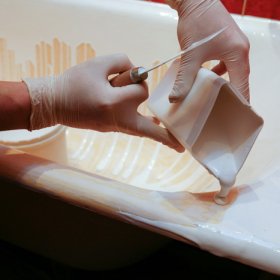
Sooner or later, the bath, which once delighted the eye with sparkling whiteness and brilliance, begins to unpleasantly surprise with roughness, a dirty yellow tint and rust. It is not a matter of the hostess’s ineptitude, just the equipment has a certain service life. Over time, the enamel becomes thinner, becomes rough and gets an unpleasant indelible shade. In this case, you must either replace the old plumbing, or try to restore its previous appearance. In the first embodiment, everything is simple and clear, but in the second you can install an acrylic liner or apply enamel for the restoration of bathtubs, which is much easier and cheaper.
Should I enamel the bath at all?
Enameling is the process of applying enamel to equipment. Ideally, it takes place in an industrial enterprise and involves strong heating of the metal, which is coated with a protective coating. At home, this is certainly not possible. However, there are compositions that allow enameling without heating. Thus, it is possible to quickly and fairly simply, without carrying out dismantling and other labor-intensive work, get an updated protective coating.
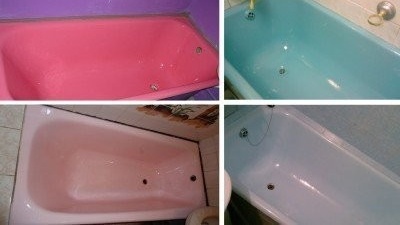
The enamel used to restore the bath can be tinted with special tinting pastes, which allows you to get almost any shade
It must also be understood that the new enamel layer applied using this technology will differ from the original. In order not to be disappointed, you should know about the features of the coating:
- The enamel layer applied to the bath has less durability, but it is maintainable. It can be updated.
- When applying enamel, it is possible to choose its color. For this, special tinting pastes are used. In this case, you need to pay attention to the thickness of the coating layer. If it is thin, the original color may give an undesirable hue.
- During operation, the shade of enamel can change under the influence of various chemicals: dyes, bleaches or photoreagents.
- Sharp or heavy objects falling into the bathtub even from a small height can cause damage to the coating.
- Reconstituted enamel can only be washed with soapy solutions, without the use of abrasive products.
The disadvantages of enameling are considered the fragility and fragility of the applied coating. However, this is not quite true. Its operational characteristics directly depend on the accuracy of the manufacturer's instructions and the correctness of the work. A significant role is played by the competent choice of composition.
What enamels are and which one is better to get?
Specialty stores offer many options for restoration tools. In order not to be mistaken, you need to know what to look for when choosing an effective enamel reducer for baths:
- The coating can be applied in different ways: roller, brush, spray.You need to know that the latter is intended, rather, to eliminate small defects. It is of little use for working on large planes: as a result, a coating of non-uniform color most often results. The best option - applying enamel with a brush.
- The composition should be sold complete with all necessary components for work. The surface of the old bathtub, with impurities deposited on it, must be carefully prepared for applying a new coating. Well, if complete with enamel and hardener will go special means for pre-cleaning equipment.
- A two-component enamel needs a hardener. Look at its color. If it is dark red, dark yellow or dark brown, an undesirable shade may appear on the coating.
Visually, the shade of enamel depends on the degree of illumination of the room. It is better to choose it in the room where the equipment will be installed. Therefore, the best option is to purchase a composition with a set of tinting pastes.
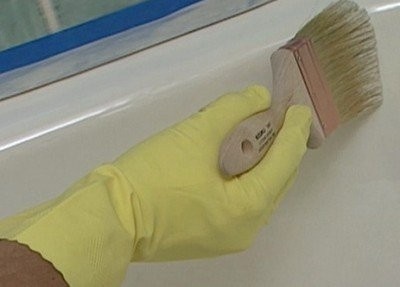
The easiest and most effective way to apply enamel to a bath is to use a brush. This method allows you to well grind the composition and prevent the appearance of sagging on the walls of the equipment
Enameling can be done independently or you can invite specialists from a company that provides such services. In any case, you have to decide which enamel for the bath is better. Professionals argue that for enameling you need to choose only a specially designed tool. For work are used:
Option # 1 - kits from the Random House
The Russian manufacturer “Random House” produces two versions of sets for the restoration of bathtubs: “Fantasy” and “Svetlana”. Their main difference is in the configuration. Both contain a two-component enamel with a hardener, which has a certificate confirming its compliance with all hygienic requirements, and a special tool for preparatory chemical-mechanical treatment of the surface of the bath.
Option # 2 - Epoxin-51 or Epoxin-51C enamel
Thick two-component enamels designed for brush application. Allows you to get a smooth layer without sagging, well filling various surface defects. Have a certificate of conformity. With proper installation, they can be used for more than 9 years. Enamels completely dry up to a maximum of two days after work. A certain difficulty lies in the even coating, which makes it particularly dense.
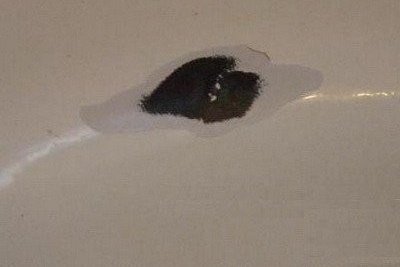
Especially thick enamel Epoxin-51 and Epoxin-51C fills very small defects very well and does not require preliminary puttying of such damage
Option # 3 - STAKRYL enamel
The material in its composition is liquid acrylic, which is intended for application to the bath by pouring. It requires careful preparation of the surface, which is carried out using a special power tool. STACRYL does not close up various chips and similar defects, therefore, additional puttying of damaged fragments will be required. The coating is sensitive to moisture on the treated surface.
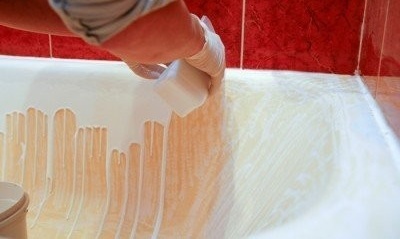
STACRYL enamel, which is liquid acrylic, is applied to the surface of a restored bath by pouring, which requires certain skills to work with such material
Here is an example of performing restoration work by the filling method. As you can see, this process requires some skill:
Option # 4 - Reaflex-50 enamel
The composition is made by Tikkurila, most often used for professional work. Enamel allows you to get a good result of the restoration of old equipment. However, it is quite difficult to apply: the material is very liquid. It is required to lay at least four coating layers, otherwise it will not be possible to close the old surface. Each coat needs to dry before applying the next.In general, it takes about seven days to work.
Summary
The range of enamels for restoration of baths is constantly expanding. From this variety it is quite easy to choose the best option for yourself. It is only necessary to determine whether the work will be carried out independently or will have to use the services of professionals. The type of composition depends on this. Given the complexity and complexity of the preparatory work, it is easier to trust specialists and in a short time enjoy the look of a completely transformed plumbing equipment.
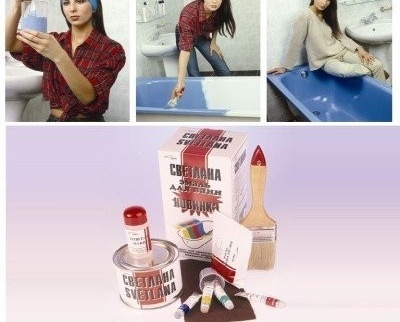

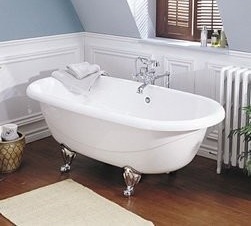

5 comments